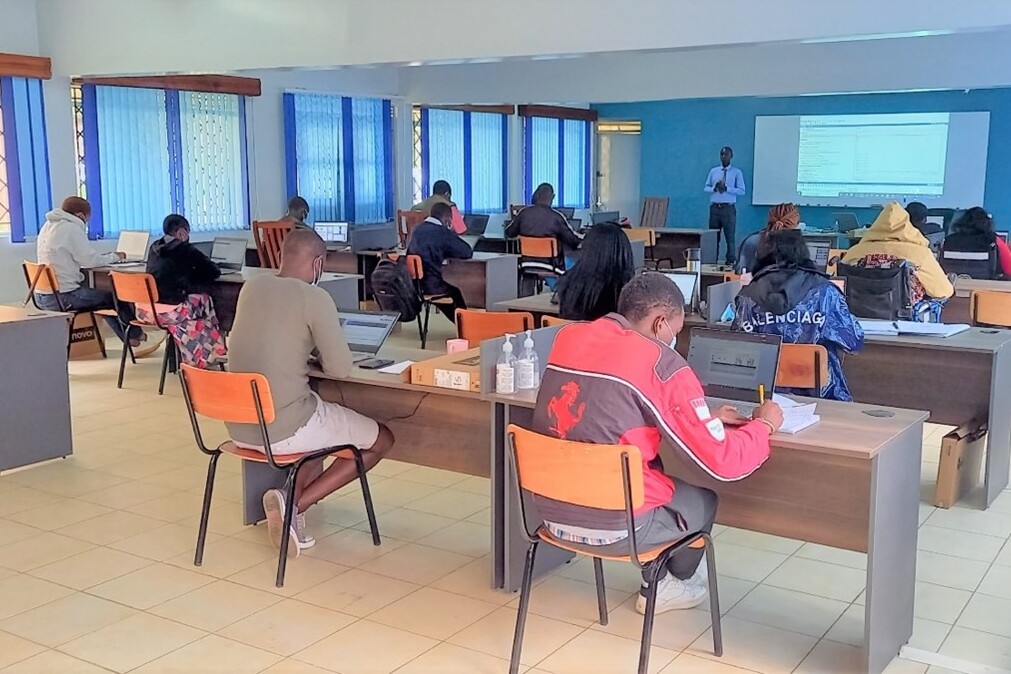
GIZ and Sightsavers, Kenya

Overview
An estimated four million people live with disabilities amongst Kenya’s population of 54 million. Only 1% of them have jobs, compared to 73.8% of the general population. Low levels of education and lack of access to information are the main challenges restricting employment opportunities for persons with disabilities. The 2009 census found that men with disabilities were more than twice as likely (14%) as women with disabilities (6.6%) to have worked for pay.
According to the USA-based Bridge Academy , the employment rate of people with a disability with a high school degree is less than half that of others, while there is also a significant employment gap between tertiary graduates with and without a disability of 85% versus 57%. While these statistics apply to the USA, they are similar globally. In addition, there are currently 1.5 million jobs in the network security industry globally. However, employers seeking to hire candidates with disabilities find that many lack the minimum requirements for most entry level “knowledge worker” jobs.
The Kenyan government supports people with disabilities to find jobs, mainly through the Disability Act of 2003, which aims to ensure such people have access to rehabilitation as well as equal rights and job opportunities. It is imperative that the government gives recognition to prior learning.
In line with the government’s efforts, GIZ and Sightsavers launched the project “Building resilient IT skills supply through demand generated ecosystems (BRIDGE)” in November 2020, in which young people with disabilities receive demand-driven skill training courses in IT security. Sightsavers works in more than 30 countries to prevent avoidable blindness and fight for the rights of people with disabilities. Sightsavers also advocate for the rights of youth with visual impairments and other disabilities.
The objective of this pilot project is to increase representation of youth - women and men - with disabilities in demand-driven formal employment. The target group in the project is Kenyan youth with disabilities (ages 18 to 29), with a 50% participation of women with disabilities. The pilot project started in November 2020 in Kenya and will conclude in December 2021.
Good Practice Approach
The project uses the Bridge Academy approach in which the CISCO Certified Network Associate curriculum is used to create a 15- to 18-month training programme that includes technical upskilling, a 3-month internship and support in finding jobs. The USA-based Bridge Academy is committed to transforming disability employment by providing employable skills and work experience. Employment rates of graduates from the Bridge Academy are over 90%. Graduates are certified by industry leaders CISCO for in-demand IT opportunities.
This overcomes education barriers, equips them with demand driven skills and prepares candidates for high paying IT jobs.
CISCO’s LifeChanger programme has developed novel applications for its voice, video and collaboration technology and combined them with process improvements to facilitate youth with disabilities being trained in network security skills. The project complements the CISCO curriculum with Accenture’s “Skills to Succeed Learning.
Exchange” training modules, which cover STEM skills (science, technology, engineering and mathematics).
The recruitment of participants is in collaboration with the United Disabled Persons of Kenya, and the focus is on people who aspire to work in IT, irrespective of academic level. The technical skills development courses are delivered in facilities of the National Industrial Training Authority (NITA) in Nairobi. Renovations such as widening doors and building ramps made the premises more accessible to the youth.
After the training, all students will gain first work experience through internships at a major Kenyan telecommunications company (Safaricom).
Key Results
Currently the first cohort of 40 students (50% women) are being trained. So far, 39 out of 40 have performed well during the training.
Lessons Learnt
• Success Factors
The project is the first of its kind in Africa involving the training of disabled youth in market oriented and complex IT-skills.
The key enabling factor of this project is the successful partnership setup between two main partners (GIZ and Sightsavers) plus other organisations with specific expertise. The cooperation of the various partners was efficiently managed by Sightsavers:
1. Three Talents: Creators of the IT Bridge Academy model in the US.
2. Cisco: Provides the technical curriculum and technical knowhow.
3. Accenture: Design of financial sustainability model for the academies.
4. Safaricom: Private sector partner providing internships for the graduates.
5. United Disabled Persons of Kenya: Mobilisation of students.
6. NITA: Training institution providing the physical infrastructure.
• Challenges/Barriers
Specific challenges and barriers will be identified once the first cohort of students complete the training and internships.
Moving Forward
The project is currently discussing several upscale modalities (upscale of E4D project, setup of a large PPP, etc.)
Resources
Sightsavers: https://www.sightsavers.org/
CISCO LifeChanger programme: https://www.cisco.com/c/dam/en_us/about/inclusion-collaboration/life-changer.pdf
United Disabled Persons of Kenya: https://www.udpkenya.or.ke/
Email: Luis.bosch@giz.de


